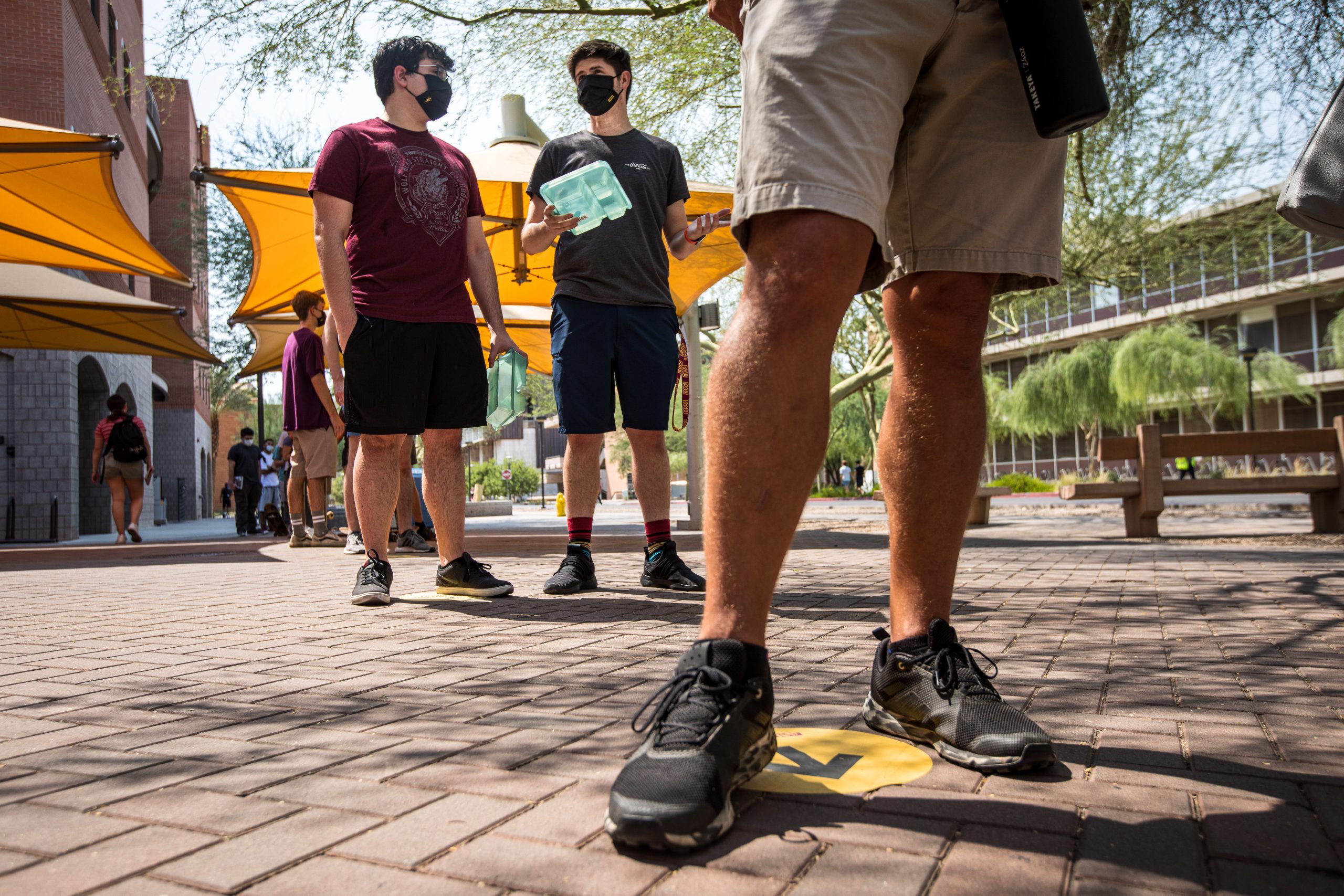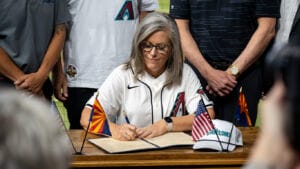First-year on-campus students are up 12% at ASU
Yoselin Flor Aguilar traveled 10 minutes from her home to start her journey at Arizona State University’s Downtown Phoenix campus this week.
Sophomore Arya Lukka traveled nearly 1,500 miles from Seattle to finally take in-person classes on the Tempe campus.
While the travel time is very different for the two students, their excitement is the same. They are among a record number of on-campus Sun Devils at ASU for the fall 2021 semester. And Aguilar is part of the largest class of first-year, on-campus students ever at ASU — more than 14,350, a 12% increase (and some 1,500 students) over fall 2020.
READ ALSO: ASU ranked No. 1 in innovation for 6th year
Overall university enrollment will be at more than 134,500 undergraduate and graduate students when fall semester classes begin this Thursday, an increase of more than 7,000 students from fall 2020. ASU’s record total enrollment looks like this:
• Over 77,000 students are taking classes in person across ASU’s campuses and other locations, compared with 74,000 last year — an increase of more than 4%.
• About 57,000 students are taking classes through ASU Online, compared with about 52,500 last year — an increase of more than 8%.
• Approximately 10,800 International students from 152 countries are enrolled in on-campus and online degree programs, compared with 8,600 last year, about a 25% increase.
• Nearly 28,000 graduate students are enrolled in on-campus and online degree programs, compared with 24,700 last year — a 13.4% increase.
Of particular note is the enrollment of veterans and military-affiliated students. As ASU celebrates the 10th anniversary of the Pat Tillman Veteran Center, the university will welcome over 10,300 on-campus and online students who are veterans or affiliated with the military for fall 2021 — a 395% increase over when the center launched in 2011, when only 2,086 such students were enrolled at ASU.
The record on-campus, first-year student class of more than 14,350 students is composed of:
• More than 8,550 Arizona residents, nearly 60% of the class and true to ASU’s commitment to serve Arizonans — a nearly 4% increase from a year ago.
• Over 5,000 students from out of state, the most ever and a 29% increase from a year ago. More than 1,500 of these students come from California, a university record for students from that state.
• More than 700 international students from 67 countries, an increase of nearly 17% from a year ago.
• One of the most academically prepared to join ASU, with an average unweighted high school GPA of 3.54.
• More than 7,300 students who received one of ASU’s three highest-value New American University Scholarships, a 9% increase from the 2020 class.
• Some 45% who identify as students from underrepresented populations, a continued indicator of ASU’s diverse community of students and a percentage that has held consistent for nearly a decade.
• Nearly one in three who are first-generation college students.
Aguilar, who will live in Taylor Place on the Downtown Phoenix campus and is majoring in criminology, is among those first-year students who are the first in their families to go to college.
“I’m the first to attend college and the first to graduate from high school,” she said.
“I’m so excited to be on campus and be independent and meet new friends and make my parents proud. It’s something I’ve been working for for a long time.”
Executive Vice President and University Provost Nancy Gonzales, herself a first-generation college student from Miami, Arizona, and an ASU graduate (Bachelor of Science in psychology and biology), says the university is ready to serve students who are starting out, as well as those continuing their academic journeys.
“Our entire academic community has worked tirelessly to create an enriching teaching and learning environment this fall semester,” Gonzales said. “I am so proud of the faculty and students who have kept their education, research and academic goals as their focus during an incredibly challenging time for so many. The record number of students joining us on campuses, at locations and online exemplifies the resolve of ASU students and is proof of the quality and value of an ASU academic experience.”
Aguilar said she’s not nervous at all about joining the record number of learners at ASU.
“It shows that a lot of people want to go to ASU … and I know they’ll be ready for us,” she said.
Anticipating the full return of students to in-person living and learning on campus, the university prepared extensively to help protect the health and wellness of the ASU community during the fall semester, including offering free COVID-19 testing and vaccinations for all students, faculty and staff, and developing COVID-19 management strategies if Sun Devils are exposed to or diagnosed with COVID-19. Students were required to take Community of Care training prior to the start of the semester, and throughout the summer, students received regular updates regarding what to expect for the fall 2021 semester.
“The past year and a half has been a time of unprecedented challenges and demonstrated resilience for our university,” said ASU President Michael M. Crow. “The ASU community has shown its grit in all sorts of ways, from stepping up to serve on the front lines to provide COVID tests and vaccines to finding opportunities to thrive in a completely new learning modality. And as we welcome this fall’s record number of students, we will continue this trajectory while we call upon our Sun Devils’ resolve and compassion to care for one another.”
Second-year student Lukka is majoring in biological sciences with a minor in global health and plans for a career in medicine. She’ll be among more than 54,000 learners on the Tempe campus, a nearly 6% increase over last year. The Polytechnic campus, located in Mesa, had the biggest jump in on-campus enrollment with an 8% increase, and now is home to more than 5,400 students.
Lukka stayed home in Seattle to take her ASU classes last year because of the pandemic. And while she was in the cohort that didn’t get to have some of the “milestone” first-year experiences, she made the most of her time.
“Honestly, I really enjoyed my year at home, and I made a lot of connections and figured out what I want to do when I get onto campus and what workload I can handle,” said Lukka, who is in Barrett, The Honors College and will live on campus.
She’ll be working as a research assistant in the Virginia G. Piper Center for Personalized Diagnostics in ASU’s Biodesign Institute and is the creative director for the United Society of South Asians student organization.
“I’m really excited to start my lab position, and I’m going to be starting a club,” said Lukka, who will work to launch an organization that will raise money to provide education and supplies to girls in rural India. “I’m looking forward to connecting with new people and digging deeper into what I love to do — medicine — and a new environment.”
Story from Arizona State University
UArizona welcomes largest incoming class ever
With more than 8,700 incoming first-year students, the University of Arizona will welcome its largest first-year class in history when classes begin on Monday.
That number eclipses the previous record set by the university in 2015 of just over 8,000 first-year students. It’s also an increase of more than 1,300 first-year students compared with last year.
The university will also welcome a very academically prepared first-year class, with an average high school GPA of 3.62, an average ACT score of 26 out of a possible 36, and an average SAT score of 1276 out of a possible 1600.
The newest class is also very diverse, with about 45% of incoming first-year students self-identifying with ethnicities other than white. About one-third of the students in the incoming class are the first in their families to attend college.
The university also saw a record number of first-year student applications this year, at nearly 48,000. Last year, even at the height of the COVID-19 pandemic, the university received more than 43,000 applications from first-year students
This year’s total enrollment has surpassed 47,300 and will continue to grow as more students complete registration. All enrollment data is preliminary until the census next month.
Classes will begin in person capacity on Monday with face-mask guidelines requiring students and employees to cover their faces in indoor settings where adequate and continuous distancing is not possible. The university also has several other safety protocols in place to reduce the impact of COVID-19 on campus.
“I am so proud to welcome our largest class of first-year Wildcats to campus for a new year of learning and exploration. This year’s incoming class demonstrates our strong commitment to being one of the most inclusive universities in the nation and world,” said University of Arizona President Robert C. Robbins. “Even as we work through the challenges that the pandemic poses, we look forward to offering students opportunities to continue pursuing their education and career goals.”
The university has also enrolled over 2,400 transfer students and will continue to register students through the first week of classes. Transfer student applications also set a university record this year, with 8,000 applications.
Arizona Online‘s incoming fall enrollment is nearly 7,000 students, including about 900 transfer students. Online students can enroll year-round.
Numbers from this year’s class suggest that the university’s efforts to adapt amid the COVID-19 pandemic have paid off, said Kasey Urquídez, vice president for enrollment management and dean of undergraduate admissions.
“Because we had to jump into action to create all the virtual opportunities, we opened up some access so students who couldn’t visit us were able to really see and find out if this was the place for them, even though they couldn’t physically visit,” she said.
The increases in overall first-year enrollment illustrate the commitment the university has made to recruitment efforts as part of its strategic plan, Urquídez said.
“When we started the strategic plan, we really invested across the country and the state,” she said. “We started recruiting these students earlier, so they’ve been hearing from us since the end of their first year of high school. We’ve had much more reach and interaction with these students and have been recruiting them for years.”




